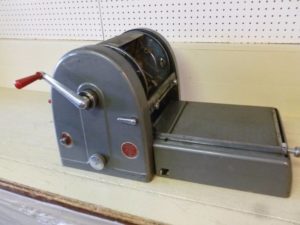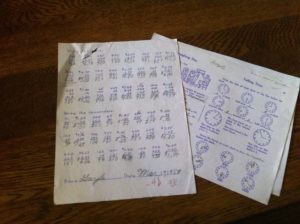
The Xerox copier made its debut in 1959, with the 914 model. It was a technological marvel that would scan a document, then spit out a nearly flawless copy.
It was also very expensive, and school budgets being what they were (and still are), that meant that teachers who wanted duplicate test papers or any other types of duplicated handouts needed to be adept at running something called a mimeograph machine. Generally, there would be one to share among several teachers.
I make lots of typos as I write these columns. I recognize most of them because Firefox underlines suspected goofs in red. All I have to do is right-click on the questioned word and I am offered suggested fixes, one of which is usually correct.
But teachers in the 60’s had to be PERFECT typists. That’s because there was no room for error, the first step in creating a mimeograph was to insert a waxed stencil into the typewriter, set it to punch letters directly onto the stencil, bypassing the ribbon, and DON’T make a mistake! If the teacher was writing up exams or graduation announcements the stencil could not be corrected. The expensive sheets had to be used very carefully so that the exams or announcements would be perfect on the first attempt.

Once the test was painstakingly typed out, the sheet was attached to a drum inside a hand-cranked mimeograph machine. Each turn of the crank drew a sheet of paper inside, where it was pressed against the stencil and ink would be printed matching the punched letters. The result was a duplicate of the original, albeit with extra lines caused by wrinkles and such on the stencil.
One of the delightful smells we enjoyed in the schoolroom was fresh mimeograph ink. I remember being handed a freshly printed test on a piece of paper that was slightly damp that smelled heavenly.
If you ever smelled a mimeographed page, you know what I’m talking about. If you haven’t, the smell, slightly chemical, is difficult to describe. But it delighted the entire class to receive the fragrant sheets.
Teachers, on the other hand, weren’t so crazy about the devices that produced them. Mimeograph machines were prone to various malfunctions. You could get ink on your hands or clothing. A rookie might put the stencil on the drum backwards, making a perfect copy of a test printed in mirror image. And the stencil could simply wear out, making the last tests unreadable.
But mimeograph machines were a part of our growing up, and if you could ever get your hands on one of those freshly printed sheets and smell its reassuring aroma, you would instantly be transported back to being eight years old again.
Not long ago, I needed a recipe and began flipping thru my old cookbook … and I unexpectedly found some REAL old recipes from 7th grade cooking class that were actually pretty decent so I never tossed them. They were all printed in that familiar purple. They’re starting to fade and I’ll have to scan them to preserve them.
I helped one of my teachers afterschool once and spent an hour cranking the mimeograph machine. Wow.
I’ll never forget that slapping sound or the big exaggerated aerobic workout required. (For some reason, I’d forgotten all about the aroma! That’ll never slip my mind again.)
This is an interesting article, but the writer has confused the mimeograph machine with the spirit duplicator. The mimeograph did indeed use stencils which could be imaged on a typewriter, and the typewriter did, in effect, ‚punch holes‘ in the stencil through which ink could flow. But the copies pictured here were not mimeographed, but spirit duplicated. Spirit duplicated copies were typically purple, where as mimeographed copies typically black. The mimeograph ink smelled like ink, but spirit fluid had an alcohol base with added chemicals that gave it a pear-like scent. That smell that the author refers to is clearly the odor of spirit duplicating fluid, not mimeograph ink. Incidentally, errors on mimeograph stencils could be corrected with stencil correction fluid. While you didn’t want to make many errors, because fixing them was time consuming and the repair was not always invisible, they could, in fact, be corrected.